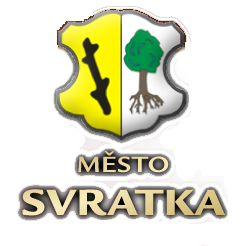The oldest written reference to Svratka dates back to 1350, that time the place belonged to the 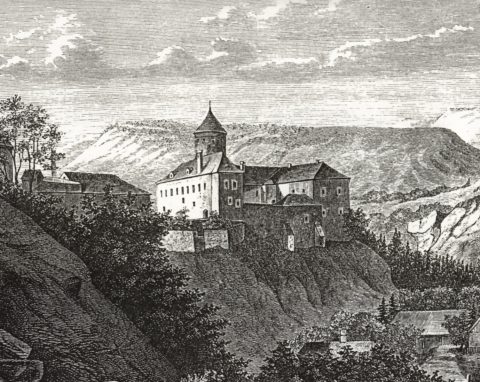 Rychmburk manor. In 1392, Smil Flaška of Pardubice conveyed the manor to hands of Ota Bergov and to Boček of Poděbrady. In the document of conveyance, Flaška enumerated all the villages of the manor. Among them, Svratka is mentioned as well.
Rychmburk manor. In 1392, Smil Flaška of Pardubice conveyed the manor to hands of Ota Bergov and to Boček of Poděbrady. In the document of conveyance, Flaška enumerated all the villages of the manor. Among them, Svratka is mentioned as well.
In 1485, the provincial scriber Martin of Dobronín put all effects belonging to the Svratka Magistrate – the little town Svratka, and the villages Svratouch, Český Herálec a České Křižánky – into the Country Laws. At that time Svratka had all town privileges.
In 1558 the Rychmburk manor was sold to Zdeněk Berka of Dubá and Lipá, the Supreme Judge of the Kingdom and the Sheriff of the District of Chrudim. During his proprietorship, Svratka was given a town emblem.
After the promulgation of the Renewed Constitution in 1627, Svratka lost its town privileges and the chartered bills were divested of the town. In the Thirty-Year-War the whole region suffered from the invasions of foreign armies, country people were driven away to the woods and the Bohemian-Moravian woods became the refuge of hard vexed outcasts. Then the violent recatholization began.
Not before 1728 and then only in 1836 markets in Svratka were certified. The start and development of industry are characteristic of the 19th century. The big factory in the Svratka region was the papermill of Ignác Fischer in Cikánka near Svratka, which replaced the extinct iron works. Matches were made in Svratka too, the most important craft was pottery, which gave more than a half of inhabitants opportunities to earn their living. Towards the end of the 19th century, pottery was being replaced by tinsmith productions, especially tin utensils were made.
In 1867 Svratka, a little town, was promoted to town. This happened when a notification of the District 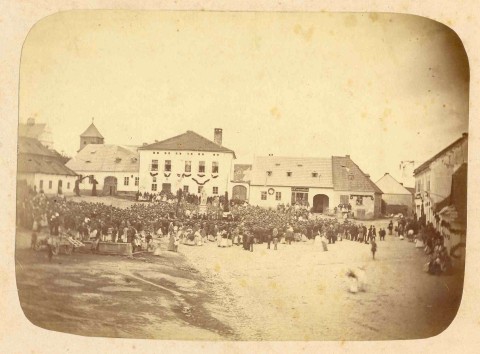 Office in Hlinsko was delivered. The notification read: „The Imperial and Royal Authority in Hlinsko notifies the political representatives in Svratka of His Imperial and Royal Apostholic, our Emperor´s most kindly highest decision from 6th July 1867 to promote the little town Svratka in the District of Hlinsko, in the Region of Chrudim, to town…“ In honour to that event, the statue of St.Wenceslas, which cost 100 golds, was made and put in the middle of the square. The statue was made by Prague sculptor Ludvík Wurzel.
Office in Hlinsko was delivered. The notification read: „The Imperial and Royal Authority in Hlinsko notifies the political representatives in Svratka of His Imperial and Royal Apostholic, our Emperor´s most kindly highest decision from 6th July 1867 to promote the little town Svratka in the District of Hlinsko, in the Region of Chrudim, to town…“ In honour to that event, the statue of St.Wenceslas, which cost 100 golds, was made and put in the middle of the square. The statue was made by Prague sculptor Ludvík Wurzel.
 Office in Hlinsko was delivered. The notification read: „The Imperial and Royal Authority in Hlinsko notifies the political representatives in Svratka of His Imperial and Royal Apostholic, our Emperor´s most kindly highest decision from 6th July 1867 to promote the little town Svratka in the District of Hlinsko, in the Region of Chrudim, to town…“ In honour to that event, the statue of St.Wenceslas, which cost 100 golds, was made and put in the middle of the square. The statue was made by Prague sculptor Ludvík Wurzel.
Office in Hlinsko was delivered. The notification read: „The Imperial and Royal Authority in Hlinsko notifies the political representatives in Svratka of His Imperial and Royal Apostholic, our Emperor´s most kindly highest decision from 6th July 1867 to promote the little town Svratka in the District of Hlinsko, in the Region of Chrudim, to town…“ In honour to that event, the statue of St.Wenceslas, which cost 100 golds, was made and put in the middle of the square. The statue was made by Prague sculptor Ludvík Wurzel.Promoting Svratka to town changed the life of the inhabitants. The town was being modernized, some houses were being reconstructed, new shops, craftmen´s workshops and pubs were opened, several clubs and associations were founded: the amateur theatre association Kollár (1877), fire brigade of voluntary firemen (in the same year), associantion of bee-keepers, gymnastic organization Sokol (Falcon), singers choir, or association of fishermen.
The World War I demanded absurd victims. The names of Svratka citizens who were killed in the war been engraved in the stone of the monument in the square. After the first independent republic was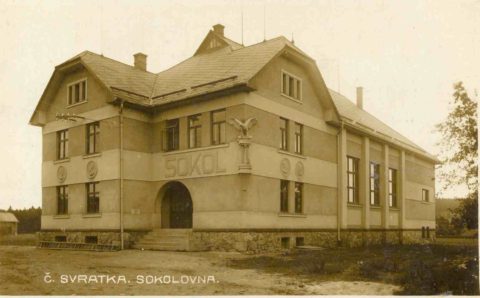 declared in 1918, the square was given the name of Tomáš Garrigue Masaryk to commemorate the first president of the republic. In 1928 the gymnastic house „Sokolovna“ was opened to public, at that time a modern building for culture, social and sporting activities. There, up to now, visitors can see the curtain of the stage, the work of the artists Josef Fiala, Jindřich Bubeníček and Cína Jelínek. These artists were-and are-admired by all people who understood the developing art of painters of the Highlands.
declared in 1918, the square was given the name of Tomáš Garrigue Masaryk to commemorate the first president of the republic. In 1928 the gymnastic house „Sokolovna“ was opened to public, at that time a modern building for culture, social and sporting activities. There, up to now, visitors can see the curtain of the stage, the work of the artists Josef Fiala, Jindřich Bubeníček and Cína Jelínek. These artists were-and are-admired by all people who understood the developing art of painters of the Highlands.
 declared in 1918, the square was given the name of Tomáš Garrigue Masaryk to commemorate the first president of the republic. In 1928 the gymnastic house „Sokolovna“ was opened to public, at that time a modern building for culture, social and sporting activities. There, up to now, visitors can see the curtain of the stage, the work of the artists Josef Fiala, Jindřich Bubeníček and Cína Jelínek. These artists were-and are-admired by all people who understood the developing art of painters of the Highlands.
declared in 1918, the square was given the name of Tomáš Garrigue Masaryk to commemorate the first president of the republic. In 1928 the gymnastic house „Sokolovna“ was opened to public, at that time a modern building for culture, social and sporting activities. There, up to now, visitors can see the curtain of the stage, the work of the artists Josef Fiala, Jindřich Bubeníček and Cína Jelínek. These artists were-and are-admired by all people who understood the developing art of painters of the Highlands.Small and bigger shops and craftmen´s workshops were being opened. Buses towards Hlinsko, Polička, Nové Město na Moravě and to the nearest train station Čachnov started to go for the first time. Tinsmiths´and file-makers´workshops began to grow. The two-staged community and tradesmen´s higher schools were founded in 1922 and 1923. Electrification was finished in 1920, telephone was introduced (1924), a road through the town was paved (1936) and new quarters of the town were built.
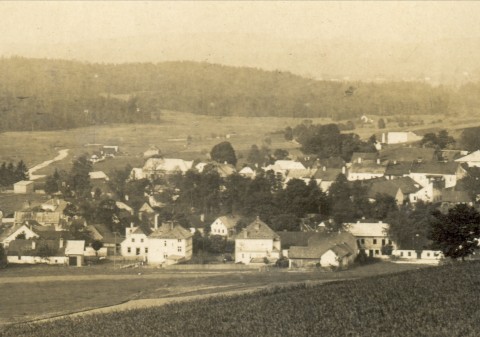 In the twenties, the Prague publisher Bedřich Tuček visited Svratka and he kept loyalty to Svratka permanently. It was he who allured tens of academic painters to the Highlands and they created their outstanding works there. In a short time, Svratka became the centre of not only tourists but of artists as well. And this fact may have been the reason why the Svratka wholesaler Jindřich Bureš intended to build a modern hotel there. Building of the hotel retained for several years, but after World War II it was finished. The name of the hotel – Mánes – became well-known to general public. Faithful visitors to Svratka and important artists, men of letters, actors, musicians, politicians and others would meet in the reastaurant „The Šiller´s“ every year.
In the twenties, the Prague publisher Bedřich Tuček visited Svratka and he kept loyalty to Svratka permanently. It was he who allured tens of academic painters to the Highlands and they created their outstanding works there. In a short time, Svratka became the centre of not only tourists but of artists as well. And this fact may have been the reason why the Svratka wholesaler Jindřich Bureš intended to build a modern hotel there. Building of the hotel retained for several years, but after World War II it was finished. The name of the hotel – Mánes – became well-known to general public. Faithful visitors to Svratka and important artists, men of letters, actors, musicians, politicians and others would meet in the reastaurant „The Šiller´s“ every year.In the period of the World War II local people proved their good characters. During the whole war they were loyal to their mother country. In the night of March 26, 1945, the group of Soviet partisans – paraschutists, called „Vpřed“ (Forward) under command of Major Nikolay J.Melničuk – Orel (Eagle) was bailed out at the edge of wood above Svratka. This commander organized a group of Czech patriots to the fight against the Nazis and he significantly took part in the fights of deliberation of Svratka and its region. Severa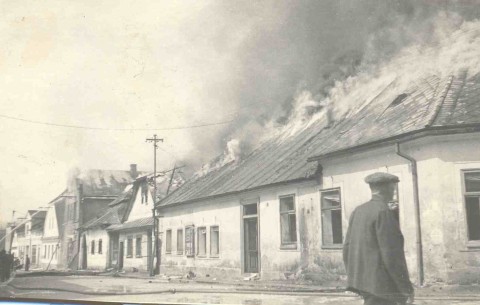 l local men gave their lives for the freedom of their country. The memorial in the square commemorates their names. Svratka was the second town in East Bohemia, where the uprising broke up on May 5, 1945. When, on May 9, the Germans gave ground and they went through Svratka, several buildings were bombed and were on fire. Today there is the bus staion and Square of 9th May. On May 11, Major Orel stated that the activities of the partisans had been finished.
l local men gave their lives for the freedom of their country. The memorial in the square commemorates their names. Svratka was the second town in East Bohemia, where the uprising broke up on May 5, 1945. When, on May 9, the Germans gave ground and they went through Svratka, several buildings were bombed and were on fire. Today there is the bus staion and Square of 9th May. On May 11, Major Orel stated that the activities of the partisans had been finished.
 l local men gave their lives for the freedom of their country. The memorial in the square commemorates their names. Svratka was the second town in East Bohemia, where the uprising broke up on May 5, 1945. When, on May 9, the Germans gave ground and they went through Svratka, several buildings were bombed and were on fire. Today there is the bus staion and Square of 9th May. On May 11, Major Orel stated that the activities of the partisans had been finished.
l local men gave their lives for the freedom of their country. The memorial in the square commemorates their names. Svratka was the second town in East Bohemia, where the uprising broke up on May 5, 1945. When, on May 9, the Germans gave ground and they went through Svratka, several buildings were bombed and were on fire. Today there is the bus staion and Square of 9th May. On May 11, Major Orel stated that the activities of the partisans had been finished.In the elections in 1946 the Communist Party won majority. The after-war restoration started with enthusiasm. The new school building (being built in 1947-1951), swimmin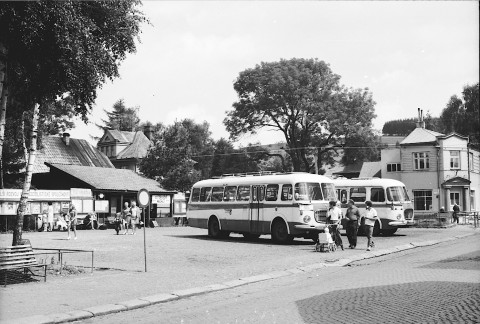 g pool and the water mains were built. Not far from the Mánes Hotel a golf course was built – it was mostly designed by the Svratka creative artist Alois Chocholáč. However, the new times also sowed discord in the after-war flourishing and development. The period of the communist dictatorship, nationalization and then the extinction of tiny workshops, private small shops, restaurants and big farms began. Farmers were forced to hand over their estate of property to big cooperative farms. Nevertheless, in the times after the World War II a lot of new houses and flats were built in Svratka.
g pool and the water mains were built. Not far from the Mánes Hotel a golf course was built – it was mostly designed by the Svratka creative artist Alois Chocholáč. However, the new times also sowed discord in the after-war flourishing and development. The period of the communist dictatorship, nationalization and then the extinction of tiny workshops, private small shops, restaurants and big farms began. Farmers were forced to hand over their estate of property to big cooperative farms. Nevertheless, in the times after the World War II a lot of new houses and flats were built in Svratka.
 g pool and the water mains were built. Not far from the Mánes Hotel a golf course was built – it was mostly designed by the Svratka creative artist Alois Chocholáč. However, the new times also sowed discord in the after-war flourishing and development. The period of the communist dictatorship, nationalization and then the extinction of tiny workshops, private small shops, restaurants and big farms began. Farmers were forced to hand over their estate of property to big cooperative farms. Nevertheless, in the times after the World War II a lot of new houses and flats were built in Svratka.
g pool and the water mains were built. Not far from the Mánes Hotel a golf course was built – it was mostly designed by the Svratka creative artist Alois Chocholáč. However, the new times also sowed discord in the after-war flourishing and development. The period of the communist dictatorship, nationalization and then the extinction of tiny workshops, private small shops, restaurants and big farms began. Farmers were forced to hand over their estate of property to big cooperative farms. Nevertheless, in the times after the World War II a lot of new houses and flats were built in Svratka.The changes after the year 1989 deeply hit Svratky, as matter of course. The supression of industries affected the life badly, on the other hand, many new shops and services were opened, houses started to look much better, new roads were asphalt surfaced. The care of living conditions and environment improved, gas was introduced in the whole town, so that the quality of the air in Svratka improved vitaly. In the year 2000 Svratka recieved a Town Charter again (in the 50s of the 20th century Svratka lost it due to the communist law). Sokolovna, the building of the gymnastic association, was completely reconstructed andbecame a worthy culture place of the town.
In 2002, the museum was restored after 40 years. The museum opened the brand new exhibition in 2005. In 2006, the gallery of the pictures made by artists of the Highlands was opened.
Today, Svratka is little town that, due to its location, offers ideal conditions for summer and winter recreation.
